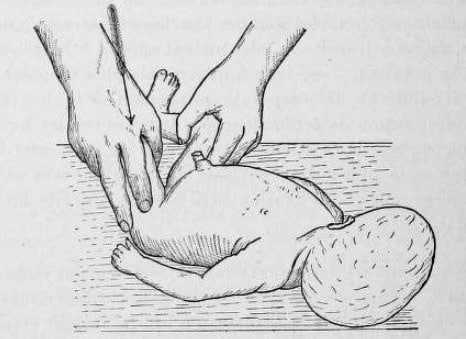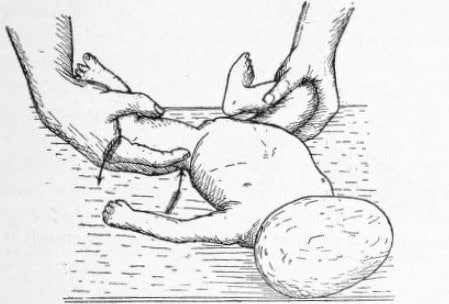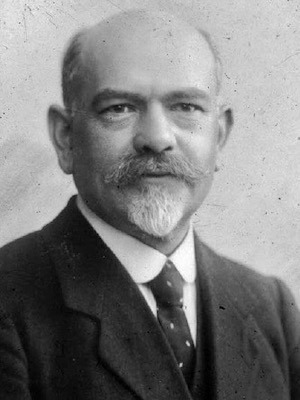Pierre Le Damany
Biography
- Born on May 27, 1870 in Lannion, France
- 1897 – Doctor of medicine, Paris
- 1898 – Chef de travaux d’anatomie et de physiologie
- 1900 – Professeur suppléant des chaires de pathologie et de clinique médicale
- 1902 – Professeur de clinique médicale et médecin-chef à l’Hôtel-Dieu de Rennes
- Died on April 20, 1963 in Rennes, France
Ne faites pas de bruit, faites du bien.
Medical Eponyms
Signe de Le Damany
Le Damany described reduction of the infant hip with abduction and termed it “signe du ressault”. He classified newborn hips into 2 types: (1) anthropologic group (our common developmental hip dysplasia); and (2) the teratologic hips associated with syndromes. This grouping remains true today. He also described the provocative hip instability test 50 years before Barlow
aka: signe du ressaut, signe d’Ortolani
Premier temps. – Fixant exactement, mais avec légèreté, la cuisse entre les trois premiers doigts allongés, il pousse le fémur en bas et en dehors, parallèlement à lui-même, comme s’il voulait luxer la tête par-dessus le bord postérieur du cotyle. Pour cela, la cuisse étant fléchie à angle droit, la commissure du pouce presse de haut en bas sur le genou, et la pulpe du pouce presse de dedans en dehors sur la face interne de la cuisse (fig. 202). Si la hanche est luxable, il se fait une subluxation, parfois révélée par une légère secousse, parfois absolument latente.

First step. – Fixing the thigh exactly, but lightly, between the first three extended fingers, he pushes the femur down and out, parallel to himself, as if he wanted to dislocate the head over the posterior edge of the acetabulum. For this, the thigh being bent at a right angle, the commissure of the thumb presses from top to bottom on the knee, and the pulp of the thumb presses from inside out on the inner face of the thigh (fig. 202). If the hip is luxable, there is a subluxation, sometimes revealed by a slight jerk, sometimes absolutely latent.

as
Deuxième temps – L’opérateur imprime à la tête du fémur un déplacement inverse du précédent (fig. 203). La pulpe du médius pousse le trochanter de dehors en dedans en même temps que la cuisse est brusquement portée en abduction. Par cette manœuvre, la tête rentre dans la cavité par-dessus le bord posté- rieur et cette rentrée s’accompagne d’un ressaut. Parfois léger, souvent fort net, ce ressaut est quelquefois suffisamment marqué pour être perçu même par l’oreille. Le double mouvement de sens inverse qui subluxe la tête puis la ramène dans le cotyle peut être renouvelé autant de fois qu’on le désire pour un contrôle soigneux. Fait avec douceur cet examen ne doit provoquer aucune douleur; il est même indispensable qu’il soit indolore, car l’état de résolution musculaire de l’enfant est nécessaire pour laisser aux sensations leur netteté. La simple précaution d’occuper l’enfant en lui donnant à boire pendant ces manipulations suffit pour supprimer les cris et les contractions musculaires gênantes.

Second step. – The operator imprints on the head of the femur a displacement opposite to the previous one. The pulp of the middle finger pushes the trochanter from out to in at the same time as the thigh is suddenly carried in abduction. By this maneuver, the head enters the cavity over the posterior edge and this reentry is accompanied by a jump. Sometimes light, often very clear, this jump is sometimes sufficiently marked to be perceived even by the ear. The double movement in the opposite direction which sublimates the head then brings it back into the acetabulum can be repeated as many times as desired for careful control. Done gently, this examination should not cause any pain; it is even essential that it be painless, for the child’s state of muscular resolution is necessary to leave the sensations clear. The simple precaution of occupying the child by giving him drink during these manipulations is enough to suppress the cries and the annoying muscular contractions.

Major Publications
- Le Damany P, Recherches sur les pleurésies séro-fibrineuses primitives et secondaires : bactériologie, nature, pathogénie. Thèse de médecine de Paris n° 66, 1897
- Le Damany P, Les épanchements pleuraux liquides. 1903
- Le Damany P, Die angeborene Hüftgelenksverrenkung. Zeitschrift Für Orthopädische Chirurgie 1908; 21: 129-169
- Le Damany P, Nouvelles recherches sur la fréquence de la luxation congénitale de la hanche, comparaison avec celle du pied-bot et du bec-de-lièvre. 1909
- Le Damany P, La luxation congénitale de la hanche; études d’anatomie comparée, d’anthropogénie normale et pathologique, déductions thérapeutiques. 1912
- Le Damany P, La luxation congénitale de la hanche. 1923
- Le Damany P, L’enfant, aperçus d’anthropogénie; la luxation de la hanche, comment l’éviter. 1956
Controversies
References
Biography
- Notice de personne. Le Damany, Pierre (1870-1963). BNF
- Bibliography. Le Damany, Pierre. WorldCat Identities
- Héry-Arnaud G, Le Nen D. Pierre Le Damany, un grand médecin breton: Souvenirs d’un étudiant en médecine, Rennes (1887-1891). Editions L’Harmattan, 2020
Eponymous terms
- Dickson JW. Pierre Le Damany on congenital dysplasia of the hip. Proc R Soc Med. 1969 Jun;62(6):575-7
Physician in training. German translator and lover of medical history.

